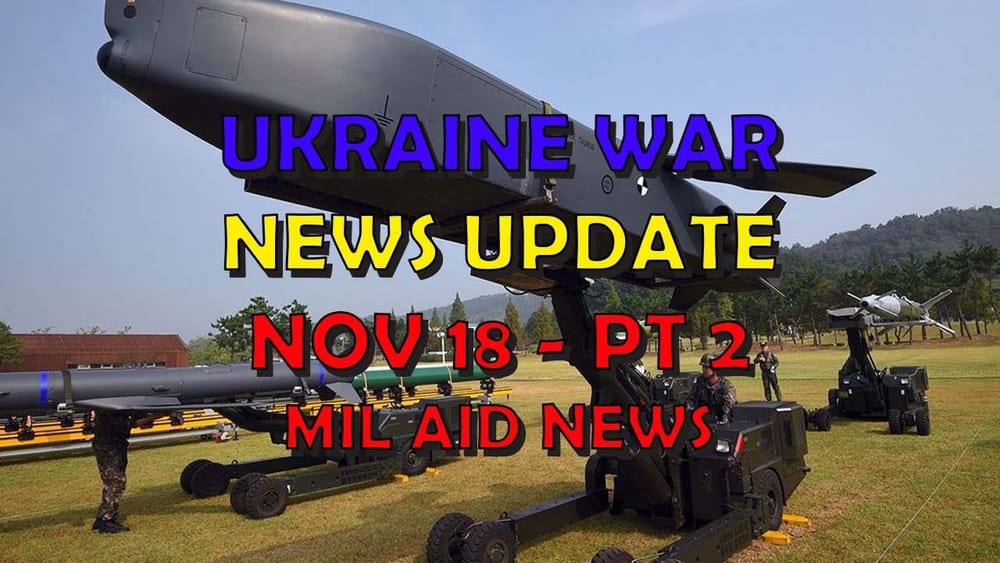Ukraine War Update NEWS: Military Aid News
Table of Contents 📖
"I think we have been in World War III, actually, for an awful long time."
Hello Team
🎦 00:00-00:29⏩
Jonathan welcomes viewers to another ATP Geopolitics update, focusing on military aid for Ukraine on November 18th, 2024. He'll delve into the recently announced lifting of restrictions on long-range ATACMS missile use, a topic covered in his previous breaking news update.
Return to top⤴️
US approves ATACMS for use in Kursk, Russia
🎦 00:29-01:12⏩
Biden has lifted the restriction on using ATACMS in the Kursk region of Russia, but not along the entire border. This decision follows the deployment of North Korean soldiers in Kursk and aims to deter further North Korean involvement. There are rumors, as yet unverified, of Biden fully lifting the restrictions. However, no news has emerged about using Storm Shadow or Scalp-EG cruise missiles in this context.
Return to top⤴️
Effectiveness of ATACMS and reactions
🎦 01:12-02:41⏩
- Jonathan is skeptical about the effectiveness of the limited ATACMS deployment as a deterrent against North Korean involvement, believing a more substantial impact would require significant casualties.
- Russian milbloggers have reacted negatively, but this mirrors their responses to previous Western military aid, including HIMARS, Storm Shadow, and Scalp-EG missiles.
- He highlights that the effectiveness of the ATACMS deployment depends on the quantity available and Russia's improving interception rate.
- Jonathan agrees with George Barros's assessment that numerous legitimate military targets within Ukraine are within ATACMS range. He supports extending their use beyond Kursk, a sentiment echoed by Barros.
- Zelensky has neither confirmed nor denied the ATACMS development, stating that the "missiles will speak for themselves," implicitly acknowledging their use.
Backlash from Trump Jr., Musk and others
🎦 02:41-03:34⏩
- Figures associated with the incoming US administration, including Donald Trump Jr. and Elon Musk, have criticized the ATACMS decision, labelling it a path to World War III.
- Jonathan dismisses these claims as alarmist, pointing out that similar pronouncements followed previous instances of Western military aid, which did not escalate into global conflict.
- He argues that a case could be made for the conflict already constituting World War III.
Germany to supply AI-powered Kamikaze drones
🎦 03:34-05:21⏩
- Germany will deliver AI-powered kamikaze drones to Ukraine starting in December, with monthly shipments of several hundred units, totalling 4,000.
- These HX2 Karma drones, produced by Helsing, are reportedly resistant to electronic warfare, can operate without GNSS, and are swarm-capable thanks to the UltraReqistrike software.
- The drones boast a 100km range with 50cm accuracy and are significantly cheaper than Switchblade 600 or Zala Lancet loitering munitions. Jonathan expresses optimism about their potential impact and the importance of inflicting costs on Russia for its aggression, particularly leading up to January 20th.
German Green Party's stance on Taurus Missiles
🎦 05:21-09:17⏩
- The Green Party chancellor candidate in Germany has pledged to send Taurus missiles to Ukraine if elected. Jonathan praises the Green Party for its mature and unwavering support for Ukraine, unlike some Green parties globally.
- However, German Defence Minister Boris Pistorius stated that providing Taurus missiles would not alter the conflict's trajectory and alluded to undisclosed factors preventing their delivery.
- Jonathan speculates on the reasons behind Germany's reluctance to send Taurus missiles, ranging from technical integration challenges to concerns about their potential capture by Russian forces. He finds Pistorius's statement intriguing, particularly as the minister had previously supported sending the missiles to Ukraine.
- Jonathan addresses a YouTube comment from "German Aid to Ukraine," clarifying that the potential FDP-initiated vote on sending Taurus missiles to Ukraine is not legally binding and unlikely to happen before mid-2025. Even if approved, integrating and certifying the missiles onto Ukrainian aircraft would take several months. While estimates for adapting the planes vary, Jonathan doubts Taurus missiles will be operational in Ukraine anytime soon.
Ukraine's new T-150 drone
🎦 09:17-09:44⏩
Jonathan, citing Andrew Perpetua, marvels at the size of Ukraine's new T-150 drone. The large quadcopter drone, equipped with counterbalancing double rotor blades, highlights the diverse range of unmanned aerial vehicles employed by both sides in the conflict.
Return to top⤴️
Viewer deep dive on Ukrainian air defence systems
🎦 09:44-16:09⏩
- Jonathan reads and responds to a detailed comment from viewer John Oliver, who delves into Ukraine's air defence capabilities.
- John observes that while Ukraine possessed a significant number of S-300 air defence systems, they are aging, and interceptor missiles are dwindling. He notes that the US is collaborating with Ukraine to manufacture replacements and establish domestic production facilities for more modern, upgraded systems.
- Jonathan acknowledges the limited reporting on this collaboration. He corrects John's assertion that only two out of eight pledged IRIS-T systems have been delivered, stating that six are already operational, with the remaining two in production.
- He praises the IRIS-T system's impressive interception rate of over 90% against cruise missiles near Kyiv, emphasizing the significant impact six more units would have.
- John expresses a desire for road-mobile air defence systems with capabilities approaching the RST, suggesting that Ukraine's domestic production could focus on this.
- He notes that the Avenger system, essentially Stinger MANPADS mounted on Humvees, lacks sufficient range for frontline deployment. While effective against helicopters at close range, they are vulnerable to helicopter-launched Vikhr missiles beyond that range. Vikhr missiles posed a significant challenge to the Ukrainian counteroffensive in 2023.
- John suggests that the US should allocate aid to bolster Ukraine's indigenous production facilities, enabling them to become more self-reliant in developing air defence systems, even if future aid is curtailed. He highlights the success of Ukraine's drone defence, nearing a 100% interception rate, and argues that bolstering air and missile defence across crucial areas would significantly enhance Ukraine's defensive capabilities.
- Jonathan expresses frustration with the slow and incremental nature of Western aid, from the initial hesitation and lack of urgency to the delays, restrictions, and drip-feeding of supplies.
- He agrees with John's assessment that this approach has come at a cost. He attributes the slow response to a combination of anti-escalation concerns, miscalculations about the war's duration (influenced partly by Ukraine's early successes), and the West's underestimation of Russia's resilience.
- Jonathan believes the Biden administration will come to regret its cautious approach. He acknowledges that while his initial theory proposed intentional drip-feeding to weaken Russia in the long term, he now believes it resulted from miscalculations and an overemphasis on preventing escalation.
Russia's Gebera decoy drone
🎦 16:09-17:21⏩
- Jonathan discusses Ukraine's Defense Intelligence examination of Russia's Gebera drone. This decoy drone is designed to mimic the Shahid-136, overwhelming Ukrainian air defenses.
- Constructed from inexpensive materials like plywood and foam, it incorporates foreign components from China, the US, the Netherlands, and Switzerland. Jonathan notes that not all drones shot down are armed; some are decoys or used for mapping.
China's military spending
🎦 17:21-19:52⏩
- Citing the American Enterprise Institute (AEI), Jonathan shifts focus to China's military spending, noting the think tank's generally reliable stance on the Ukraine war.
- While the US is known for its massive defence budget, outspending the next 12 countries combined, the AEI estimates that China's actual military expenditure is about 96% of US levels. This estimate far exceeds the official figures based on market exchange rates.
- Jonathan cites Mackenzie Eaglin's comment that the AEI's findings highlight China's real military spending and substantial investments in combat power, dwarfing those of its Indo-Pacific neighbors. He agrees that the US and its allies, including NATO, Japan, South Korea, Australia, and New Zealand, are right to be wary of China's growing military might.
- Jonathan believes China is observing the US response to Ukraine as a gauge for a potential Taiwan scenario. He argues that the US's handling of the situation sends concerning signals to an increasingly emboldened China.
- While China's publicly declared military budget is $229 billion, intelligence estimates place it around $700 billion. The AEI's estimate of $710.6 billion aligns closely with these figures, suggesting significant underreporting by China.
- Jonathan concludes by expressing concern over China's potentially much larger-than-acknowledged defence spending.
Wrap up
🎦 19:52-19:58⏩
Jonathan thanks his viewers for their continued support and for watching the update.
Return to top⤴️



